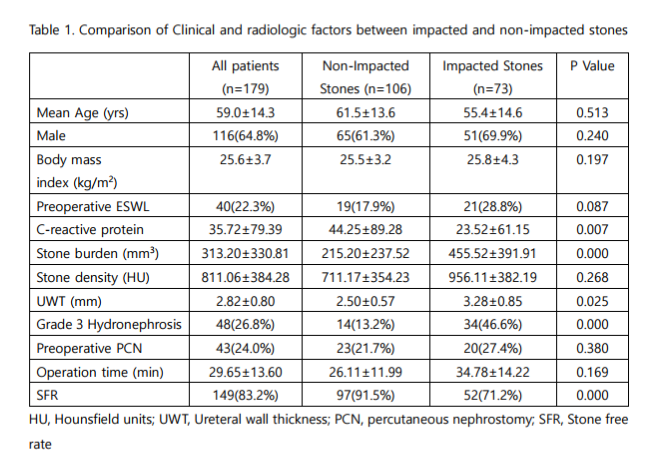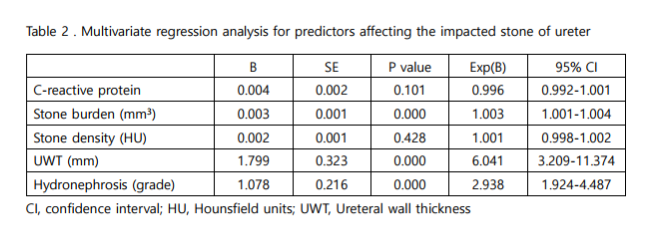Back
Poster, Podium & Video Sessions
Moderated Poster
MP14: Stone Disease: Surgical Therapy (including ESWL) I
MP14-13: Predicting factors and Stone free rate of Impacted Ureteral Stones
Friday, May 13, 2022
2:45 PM – 4:00 PM
Location: Room 225
Tae Hoon Oh, Seung Chul Park, Ill Young Seo*, Iksan, Korea, Republic of
- IS
Poster Presenter(s)
Introduction: To evaluate predicting factors for impacted ureteral stone and describe stone free rates of ureteroscopic treatment for impacted compared with non-impacted ureteral stones.
Methods: We retrospectively analyzed 179 patients who underwent ureteroscopic lithotripsy (URSL) for ureteral stones diagnosed by computed tomography (CT) between January 2019 and December 2020. Clinical and radiologic predictors of impacted ureteral stones were assessed using univariate and multivariate logistic regression analysis. Additionally, stone free rates of impacted ureteral stones and correlated factors were evaluated.
Results: All of 179 patients, 73(40.8%) patients were diagnosed with impacted ureteral stones. An impacted stone was defined as a through which a guidewire could not be passed at the ureter stone for URSL. The stone free rate was 71.2% for impacted stone, which is lower compared with 91.5% for non-impacted stones (p < 0.001). Stone burden, hydronephrosis, C-reactive protein (CRP), ureteral wall thickness (UWT) in patients with impacted ureteral stones was significant differences on univariate analysis. Multivariate analysis showed that stone burden, hydronephrosis, UWT (odds ratio 6.041, P<0.001) were independent predictors of impacted ureteral stones. Additionally, preoperative percutaneous nephrostomy (PCN), stone burden, the using of flexible ureterorenoscope, hydronephrosis were independent predictors of affecting stone free rate for impacted ureteral stones.
Conclusions: The predictive factors such as stone burden, hydronephrosis, UWT may contribute to the preoperative diagnosis of impacted ureteral stone. Preoperative PCN and active using of flexible ureterorenoscope could be increase a stone free rate of ureteral impacted stone.
Source of Funding: The authors report no conflicts of interest.



Methods: We retrospectively analyzed 179 patients who underwent ureteroscopic lithotripsy (URSL) for ureteral stones diagnosed by computed tomography (CT) between January 2019 and December 2020. Clinical and radiologic predictors of impacted ureteral stones were assessed using univariate and multivariate logistic regression analysis. Additionally, stone free rates of impacted ureteral stones and correlated factors were evaluated.
Results: All of 179 patients, 73(40.8%) patients were diagnosed with impacted ureteral stones. An impacted stone was defined as a through which a guidewire could not be passed at the ureter stone for URSL. The stone free rate was 71.2% for impacted stone, which is lower compared with 91.5% for non-impacted stones (p < 0.001). Stone burden, hydronephrosis, C-reactive protein (CRP), ureteral wall thickness (UWT) in patients with impacted ureteral stones was significant differences on univariate analysis. Multivariate analysis showed that stone burden, hydronephrosis, UWT (odds ratio 6.041, P<0.001) were independent predictors of impacted ureteral stones. Additionally, preoperative percutaneous nephrostomy (PCN), stone burden, the using of flexible ureterorenoscope, hydronephrosis were independent predictors of affecting stone free rate for impacted ureteral stones.
Conclusions: The predictive factors such as stone burden, hydronephrosis, UWT may contribute to the preoperative diagnosis of impacted ureteral stone. Preoperative PCN and active using of flexible ureterorenoscope could be increase a stone free rate of ureteral impacted stone.
Source of Funding: The authors report no conflicts of interest.




.jpg)
.jpg)